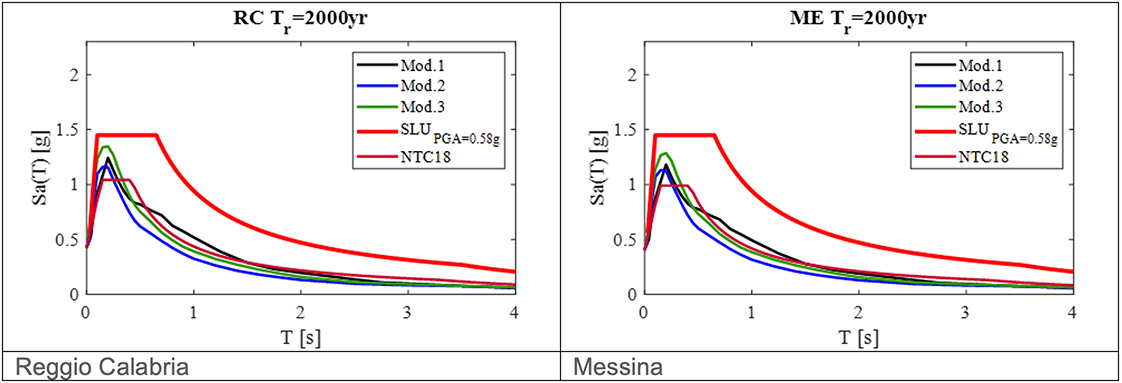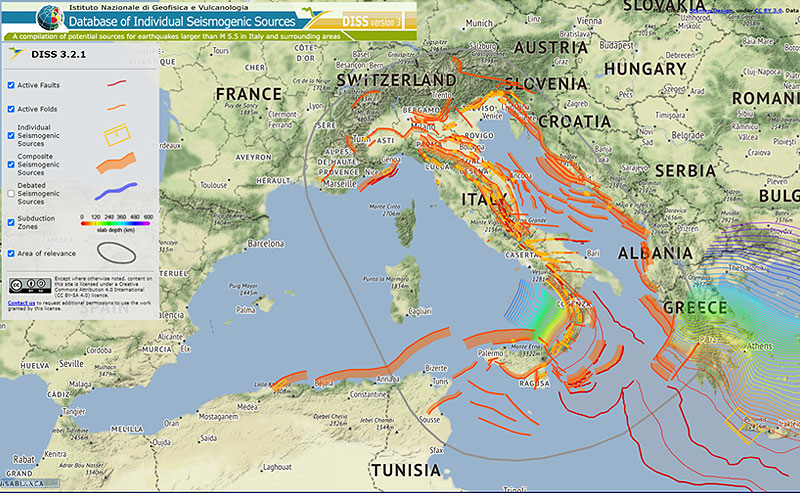SEISMIC ISSUES AND FAULTS: THE BRIDGE HAS BEEN DESIGNED WITH SEISMIC MEASURES AND CRITERIA THAT MAKE IT ONE OF THE MOST SEISMICALLY SAFE STRUCTURES IN ITALY AND THE REST OF THE WORLD
Stretto di Messina (SdM) and the National Institute of Geophysics and Volcanology (INGV) reports
The final design of the Strait of Messina Bridge is comprehensive and exhaustive, and not lacking a “seismic green light” and “certification” as reported in an article in the La Repubblica newspaper today. INGV researchers collaborated with the General Contractor, Eurolink, on drafting the final design in 2011, and on the recent update aimed at adding further details to the geo-seismotectonic framework, via bibliographic analyses, as well as on-site, geo-seismic and geological surveys. The Department of Earth Sciences at Rome’s La Sapienza University, which Eurolink has commissioned to carry out in-depth studies, recently entered into a scientific agreement with INGV to revise the geo-seismotectonic framework. Furthermore, Stretto di Messina has recently signed a technical and scientific collaboration agreement with INGV regarding management of the geotechnical monitoring network, and exchanging data and scientific information. Within the scope of these collaborations, Stretto di Messina has confirmed its willingness to set out in detail the project’s provisions relating to seismic issues.
It should be noted that preparation and approval of the final design is the outcome of a comprehensive process which, starting from the design drawn up and updated by Eurolink (the main partners are Webuild, IHI, Sacyr and Cowi, the world’s leading specialist in the construction of suspension bridges), and together with Stretto di Messina’s technical management department for in-depth verification procedures, has involved the Parsons Transportation Group as project management consultant, Edison Next as environmental monitor, and an expert panel to support technical and specialist oversight activities. The panel consists of four leading experts in the aerodynamics and aeroelasticity, seismic, geotechnical and environmental fields. The Company has also received a green light from the Scientific Committee, an autonomous and independent body.
The complex organisation of this procedure is unparalleled in Italy and around the world.
The Cannitello fault
Once again, it should be pointed out that the Cannitello fault is not seismogenic, and is therefore not capable of causing the ground to shake. This certainty stems from extensive field studies conducted in the area. These studies and surveys go into far greater depth than do those referred to in the overtly bibliographic ISPRA – ITHACA catalogue of active faults throughout Italy, which suffers from major shortcomings and is not uniformly accepted by experts. In most cases, the identification of faults is not backed up by surveys that reconstruct their geometry in depth, as is the case for the faults described in the INGV database, which does not contain the faults referred to by Mr Bonelli.
The Cannitello fault also lacks a surface expression that is unequivocally recognised by researchers with expertise in the field. Moreover, the detailed core drilling carried out for the preparation of the final design revealed no evidence of dislocation along the Cannitello fault in recent times, which might involve surface sediments that could be investigated by means of “paleoseismological trenches”.
Seismic actions and ground acceleration
It should be noted that great attention has been focused on the definition of seismic action for the bridge project since the initial stages of the design studies, given the particular nature of the Strait of Messina in terms of geo-seismotectonic issues.
The energy released by an earthquake at a site (magnitude) is closely linked to the size of the tectonic structures (faults) that are present there. Studies carried out on the Strait of Messina have concluded that the seismogenic structures present can give rise to seismic events no greater than magnitude 7.1 on the Richter scale.
Therefore, the Strait of Messina Bridge has been designed to withstand, with a margin of safety, the strongest earthquake that may be expected in the Strait area, namely an event similar to the Messina earthquake of 1908, which has been classified by studies published in the most authoritative journals in the field as an extremely rare event that is highly unlikely to recur for several centuries (the return period has been determined as 1500-2000 years). If the bridge were to be hit by such a rare earthquake, it would not suffer any damage, as its structures have been designed to remain within the elastic field, maintaining additional margins of resistance that even go beyond the expected threshold.
The Strait of Messina Bridge has been designed in accordance with specific seismic resistance criteria and parameters that are more stringent than those set out in the current 2018 Construction Regulations (Ministerial Decree of 17 January 2018 – NTC18 for short).
It should be immediately pointed out that the peak ground acceleration (PGA) data presented for recent Italian seismic events, as well as the fact that even higher peak ground accelerations are expected, are well known aspects of Italian and international expertise in this field, largely connected to the advancement of knowledge and instrumental measurements of seismic events which, in Italy as in the rest of the world, are ever more widely available.
To complete the picture, the NTC18 regulations foresee accelerations in the Messina area with maximum values of 0.42g. Therefore, it is incorrect to state that the Strait of Messina Bridge has been designed with application of “the standard value of 0.58g”; PGA values are usually significantly lower.
It should be pointed out that the PGA parameter, whose value would not be deemed as precautionary in the article, is totally insignificant from a design point of view. This is now recognised by the international scientific community, to the extent that in the new European standards currently being defined (Eurocodes review) this value is not taken into account at all.
In order to assess a structure’s seismic safety, the ground movement needs to be characterised in detail. This entails assessment of how ground oscillation occurs during a seismic event, and how the structure, which also has its own oscillation characteristics, responds to the ground movement. In technical and scientific terms, this is expressed by the “response spectrum” that is applied in the design, which is an essential and well-known element in the field of earthquake engineering.
With regard to the Strait of Messina Bridge, the area of the design spectra of interest for assessing the structure’s response is from one second upwards on the abscissa scale. Indeed, the bridge is a very flexible structure, with oscillation periods of up to more than 30 seconds, which is much longer than in ordinary structures. In particular, the most significant periods are those regarding the response of the towers, which range from approximately 2 to 4 seconds.

In comparing the NTC18 design spectra and those of the bridge’s “design fundamentals”, for an identical return period of 2000 years, the ones for the bridge’s design are much higher, and therefore more precautionary, throughout the area of interest.
As pointed out by Prof Ezio Faccioli (former full professor of earthquake engineering at the Polytechnic University of Milan and member of the Stretto di Messina expert panel) a detailed analysis of the design spectrum shows that peak acceleration reaches very high values of 1.5g for periods between 0.1 and 0.65 seconds, which is of very little concern for the bridge. On the other hand, the bridge responds to earthquakes with much higher period oscillations (approximately 3 seconds for the towers and 30 seconds for the deck), to which much lower accelerations correspond (approximately 0.4g for the towers and 0.002g for the deck). It is clear from these considerations why seismic shaking is not a particularly critical issue for the bridge.
The studies conducted as a result of the in-depth studies requested by the EIA Committee during the preliminary investigation phase also enabled a rigorous and up-to-date scientific assessment to be carried out based on regional source models, in which the possibility that the Strait of Messina may be in the epicentral area was explicitly taken into account. The values obtained with various hypotheses and models are consistently lower than the seismic actions used for design purposes, demonstrating that the corresponding choices are precautionary and remain so, even in light of the most recent scientific knowledge.
Moreover, by comparing the design earthquake spectrum with the spectrum of the earthquakes mentioned in the article (L’Aquila, Amatrice), it appears that at significant periods for the bridge, the acceleration values considered in the design are much more precautionary than those recorded.
Finally, as foreseen in the designers’ report drawn up in accordance with Law 58 of 26 May 2023, as part of the revision of the geo-seismotectonic studies envisaged for the detailed design, a first phase study carried out in September 2024 on behalf of Eurolink by the University of Naples Federico II, confirmed, on the basis of current information, the precautionary nature of the design spectrum and the PGA of 0.58g adopted for the bridge.
In other words, the Strait of Messina Bridge has intrinsic characteristics, and has been designed with seismic measures and criteria, that make it one of the most seismically safe structures in Italy and the rest of the world, based on the most modern international scientific and technical expertise.

